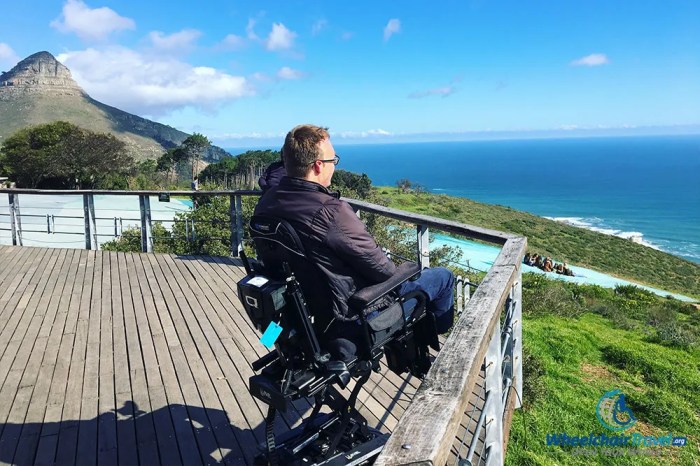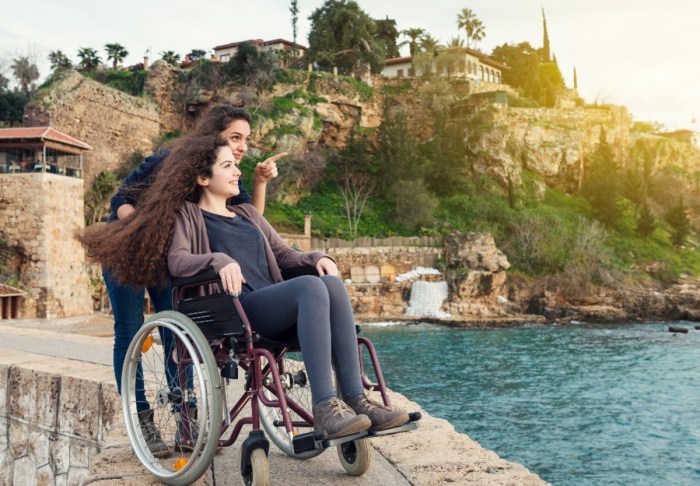
Accessible travel destinations are increasingly becoming a focus for travelers of all abilities. This guide explores the diverse world of accessible tourism, covering everything from finding affordable airfare and navigating train stations to choosing accessible cruises and finding budget-friendly accommodations. We delve into the practical considerations, providing tips and resources to help plan seamless and enjoyable trips for travelers with various accessibility needs, ensuring everyone can experience the joy of travel.
We’ll examine the key features that define accessible destinations, discuss various modes of accessible transportation, and offer insights into finding suitable accommodations, including hotels, vacation rentals, and unique lodging options. The goal is to empower travelers with disabilities to confidently plan and embark on fulfilling adventures.
Defining Accessible Travel Destinations

Accessible travel destinations are places designed and managed to welcome and cater to travelers with diverse abilities and needs. This goes beyond simply providing ramps or elevators; it encompasses a holistic approach to ensuring that individuals with a wide range of disabilities – including mobility impairments, visual impairments, auditory impairments, and cognitive impairments – can fully participate in and enjoy the travel experience.
This includes access to information, transportation, accommodation, attractions, and services.An accessible travel destination prioritizes inclusivity and equal opportunity for all. Key features and criteria include readily available accessible transportation (including public transport), accessible accommodation options (with features such as ramps, grab bars, and adaptable bathrooms), accessible attractions and activities (with appropriate signage, audio descriptions, and tactile experiences), and accessible information and communication (such as braille menus, large print materials, and sign language interpreters).
Furthermore, staff training on disability awareness and customer service is crucial for creating a truly welcoming and inclusive environment.
Accessibility Needs and Their Implications for Destination Design
The design of accessible travel destinations must address the diverse needs of travelers with disabilities. For mobility impairments, this means ensuring physical accessibility through features such as ramps, elevators, wide doorways, and accessible restrooms. Visual impairments require provisions like clear and concise signage in Braille and large print, audio descriptions for attractions, and guide dogs being readily welcomed. Auditory impairments necessitate the availability of visual aids, captioning, and sign language interpreters.
Cognitive impairments may necessitate simplified information, clear communication strategies, and sensory-friendly environments that minimize overwhelming stimuli. Destinations should anticipate and proactively address these needs to provide a seamless and enjoyable experience for all.
Legal and Ethical Considerations in Accessible Tourism
Legal considerations for accessible tourism vary by country and jurisdiction. Many countries have legislation mandating accessibility standards for public spaces and accommodations, often based on international accessibility guidelines such as the UN Convention on the Rights of Persons with Disabilities (CRPD). These laws often specify requirements for ramps, elevators, accessible restrooms, and other features. Non-compliance can lead to legal action and penalties.Ethically, accessible tourism is a matter of social justice and inclusion.
Denying individuals with disabilities the opportunity to travel and experience the world is a form of discrimination. Accessible tourism is about ensuring equal access and participation, promoting a sense of belonging, and fostering a more inclusive and equitable society. Ethical considerations extend beyond legal compliance to encompass a commitment to creating a truly welcoming and respectful environment for all travelers, regardless of their abilities.
This includes training staff to understand and respond appropriately to the needs of travelers with disabilities and actively seeking feedback to continuously improve accessibility.
Types of Accessible Travel
Accessible travel caters to a diverse range of needs and preferences, ensuring that individuals with disabilities can experience the joy of exploration and discovery. This encompasses various aspects, from the design of transportation and accommodations to the availability of information and support services. Understanding these diverse needs is crucial for creating truly inclusive travel experiences.
Accessible travel is not a monolithic concept; it’s a spectrum reflecting the unique requirements of different travelers. Consideration must be given to physical limitations, sensory impairments, cognitive differences, and other individual needs. Planning for accessible travel necessitates a thorough understanding of these variations and the resources available to meet them.
Categorization of Accessible Travel Based on Traveler Needs
Different types of accessible travel are defined primarily by the traveler’s specific needs and preferences. These needs can be broadly categorized, though individual circumstances often require a more nuanced approach.
For example, wheelchair users require accommodations focusing on physical access, such as ramps, accessible restrooms, and wider doorways. Visually impaired travelers benefit from clear audio descriptions, tactile maps, and assistance with navigation. Travelers with hearing impairments may need access to captioning, sign language interpreters, and visual alerts. Those with cognitive disabilities might need simplified information, predictable routines, and personalized support.
Accessible Transportation Modes: A Comparison
The accessibility of various transportation modes varies significantly. The following table provides a comparison of air, rail, road, and cruise travel regarding accessibility features.
| Transportation Mode | Accessibility Features | Potential Challenges | Tips for Travelers |
|---|---|---|---|
| Air Travel | Wheelchair assistance, accessible restrooms on board, pre-boarding options. | Potential for delays, limited space in overhead compartments, navigating large airports. | Book assistance in advance, notify airline of specific needs, allow extra time for travel. |
| Rail Travel | Accessible train cars, ramps, elevators, accessible restrooms. | Availability of accessible routes, potential for overcrowding, limited space for mobility devices. | Check train schedules for accessibility information, contact the rail company for assistance. |
| Road Travel | Accessible rental vehicles, accessible taxis and ride-sharing services. | Limited availability of accessible vehicles, navigating uneven terrain, finding accessible restrooms along the route. | Book accessible vehicles in advance, plan routes carefully, use navigation apps with accessibility features. |
| Cruise Travel | Accessible cabins, elevators, ramps, adapted excursions. | Limited accessibility in certain areas, potential for sea sickness, navigating ship decks. | Choose a cruise line with a strong accessibility program, book an accessible cabin, contact the cruise line for assistance. |
Accessible Travel Itineraries: Examples
Creating an accessible travel itinerary requires careful planning and consideration of the traveler’s specific needs. The following examples illustrate potential itineraries for various destinations and traveler profiles:
Example 1: Wheelchair User in London, England: A five-day itinerary could include visits to accessible landmarks like the Tower of London (with pre-booked wheelchair access), the British Museum (with ramps and elevators), and a ride on the accessible London Underground. Accommodation would be chosen based on accessibility features and proximity to key attractions.
Example 2: Visually Impaired Traveler in New York City, USA: A three-day itinerary might prioritize accessible museums with audio guides and tactile exhibits, such as the Museum of Modern Art (MoMA) or the American Museum of Natural History. Navigation assistance would be arranged, and audio descriptions of landmarks and attractions would be incorporated.
Example 3: Traveler with Cognitive Disabilities in Paris, France: A four-day itinerary would focus on manageable daily schedules, with pre-booked tours and clear, concise information about activities. Familiar routines and predictable environments would be prioritized, and support personnel could be included if needed.
Flight Deals and Hacks for Accessible Travelers: Accessible Travel Destinations

Securing affordable airfare while traveling with accessibility needs can present unique challenges. However, with careful planning and the right strategies, accessible and budget-friendly air travel is achievable. This section will explore effective methods for finding affordable flights and navigating the complexities of booking accessible air travel.Finding affordable airfare requires a multi-pronged approach. Flexibility with travel dates and destinations significantly impacts pricing.
Mid-week flights and traveling during the off-season often yield lower fares. Utilizing flight comparison websites and setting up price alerts can help monitor fare fluctuations and identify the best deals. Remember to factor in the additional costs associated with wheelchair assistance and other special needs services when budgeting.
Airlines Known for Accessibility Services
Several airlines have established reputations for their commitment to accessible travel. These airlines often provide comprehensive assistance, specialized equipment, and clear policies regarding the transportation of mobility devices. Choosing an airline with a strong accessibility track record can significantly reduce stress and improve the overall travel experience.
- United Airlines: Offers a comprehensive program for passengers with disabilities, including detailed information on booking assistance, wheelchair services, and medical equipment transport.
- Delta Air Lines: Provides a dedicated customer service line and online resources for passengers with disabilities, offering assistance with booking, boarding, and in-flight care.
- American Airlines: Features a detailed accessibility policy outlining services for passengers with disabilities, including wheelchair assistance and the transportation of mobility devices.
- Air Canada: Offers a range of services for passengers with disabilities, including specialized assistance and accessible seating options.
- British Airways: Provides detailed information on its website regarding assistance for passengers with disabilities, covering various aspects of the travel journey.
Booking Accessible Flights Online: A Step-by-Step Guide
Booking accessible flights online requires careful attention to detail. It is crucial to clearly communicate your specific needs during the booking process to ensure the airline can provide appropriate accommodations.
- Visit the airline’s website: Begin by visiting the website of the airline you’ve chosen. Look for a section dedicated to accessibility or passengers with disabilities.
- Initiate the booking process: Start the standard flight booking process, ensuring to specify your travel dates and destinations.
- Declare your accessibility needs: Clearly indicate your accessibility requirements, such as the need for a wheelchair, oxygen, or other special assistance. Most airlines have specific fields or checkboxes for this information.
- Contact customer service: Following the online booking, it’s highly recommended to contact the airline’s customer service department to confirm your booking details and accessibility requirements. This ensures that your needs are properly documented and addressed.
- Review your confirmation: Carefully review your flight confirmation to ensure all accessibility requirements are accurately reflected. Contact the airline immediately if you notice any discrepancies.
Train Travel Guides for Accessible Passengers
Planning a train journey can be an exciting prospect, but for accessible travelers, it requires additional preparation and careful consideration. This guide aims to equip you with the necessary information and strategies to ensure a smooth and enjoyable rail experience. We will cover booking accessible seats, navigating train stations, using onboard facilities, and comparing accessibility features across various global train systems.
Booking Accessible Seats
Securing accessible seating is crucial for comfortable and safe travel. Most major train operators provide options for wheelchair users and passengers with other mobility needs. These options typically include designated spaces with wider aisles, accessible restrooms, and features such as ramps or lifts. When booking online, look for specific accessibility filters or contact the train company’s customer service directly.
They can guide you through the available options and help you make the most suitable reservation. It’s always advisable to book well in advance, especially during peak travel seasons, to secure your preferred seating and avoid disappointment. Providing details about your specific accessibility needs during the booking process will ensure the operator can make the necessary arrangements.
Navigating Train Stations
Train stations can present unique challenges for accessible travelers. However, many modern stations are designed with accessibility in mind. Features like ramps, elevators, tactile paving, and audible announcements are becoming increasingly common. Before your journey, familiarize yourself with the station layout using online resources or by contacting the station directly. Many train operators provide detailed accessibility maps and guides on their websites.
When arriving at the station, look for assistance points or staff members who can help you navigate to your platform. Remember to allow extra time for travel within the station, especially if you require assistance with luggage or wheelchair maneuvering.
Using Onboard Facilities
Onboard accessibility varies depending on the train operator and the age of the rolling stock. However, many modern trains offer accessible restrooms, priority seating areas, and assistance from onboard staff. Before boarding, check with the train operator about the specific accessibility features available on your chosen train. If you have specific requirements, such as assistance with meals or medication, inform the train staff in advance.
They are generally well-trained to provide assistance and ensure a comfortable journey. Many trains also offer accessible luggage storage areas, which can be beneficial for travelers with mobility limitations.
Comparison of Accessibility Features Across Train Systems, Accessible travel destinations
Accessibility standards and features vary significantly across different train systems globally. For example, some countries like Japan have highly developed accessible rail networks with features like automatic doors and level boarding, while others may have older infrastructure with limited accessibility. European rail systems generally offer a good level of accessibility, although the specific features can differ between countries and operators.
North American systems are increasingly improving their accessibility but still have room for improvement in some areas. Researching the specific accessibility features of your chosen train system is essential before your journey. Websites and independent reviews can offer valuable insights into the accessibility of particular routes and trains. Consider contacting the train operator directly for the most up-to-date and accurate information.
Tips and Advice for Planning Accessible Train Journeys
Planning ahead is crucial for a successful accessible train journey. Researching routes and train operators, understanding accessibility features, and making reservations well in advance are key steps. Contacting the train company directly to discuss your specific needs and confirm accessibility features is highly recommended. Familiarize yourself with the station layout and any assistance services available. Allow ample time for travel, especially at busy stations.
Pack light to minimize the burden of carrying luggage. Consider purchasing travel insurance that covers potential disruptions and unforeseen circumstances. Finally, don’t hesitate to seek assistance when needed – train staff are generally happy to help.
Planning accessible travel may seem daunting initially, but with careful planning and the right resources, it becomes a rewarding experience. This guide has highlighted the importance of proactive research, clear communication with service providers, and understanding the varied accessibility features offered across different modes of transportation and accommodation types. By embracing inclusive travel practices, we can ensure that the joy of exploration is accessible to everyone, regardless of ability.
FAQ Overview
What is the best time of year to travel for accessibility?
Shoulder seasons (spring and fall) often offer a balance of pleasant weather and fewer crowds, making travel easier.
How can I ensure my accessibility needs are met during my trip?
Contact service providers (airlines, hotels, etc.) directly to discuss your specific needs well in advance of your trip. Confirm accommodations and services in writing.
Are there travel insurance options for travelers with disabilities?
Yes, many travel insurance providers offer plans that cover medical expenses related to pre-existing conditions. Review policies carefully to ensure adequate coverage.
What are some resources for finding accessible travel information?
Organizations dedicated to disability rights and accessible travel often provide valuable resources, including online directories and travel guides.





